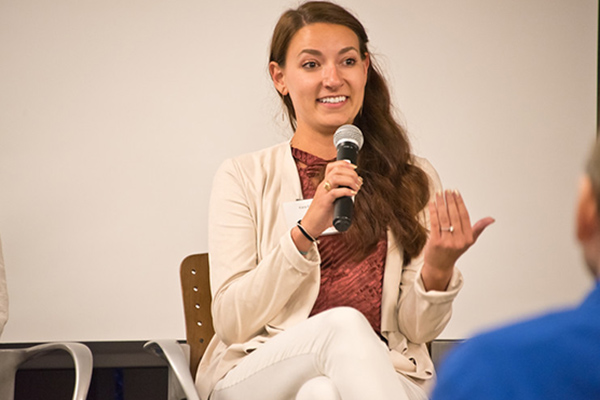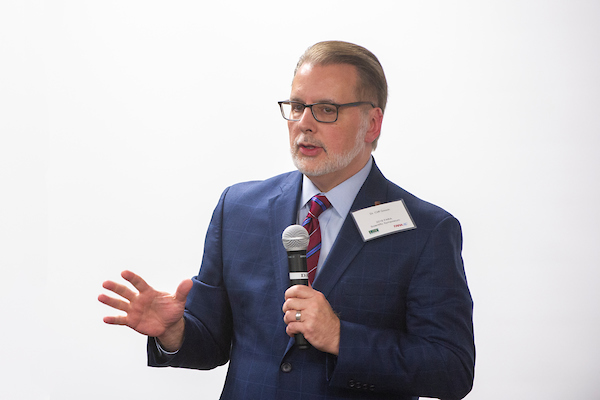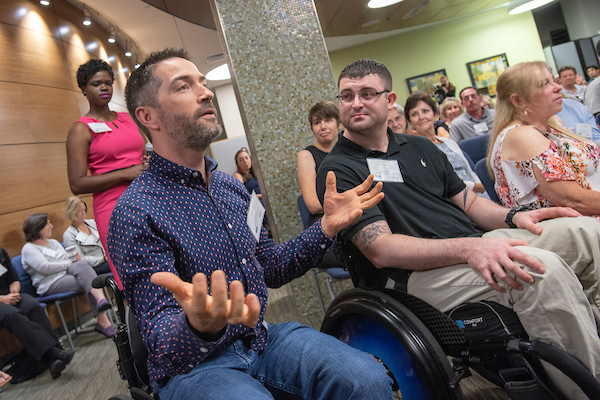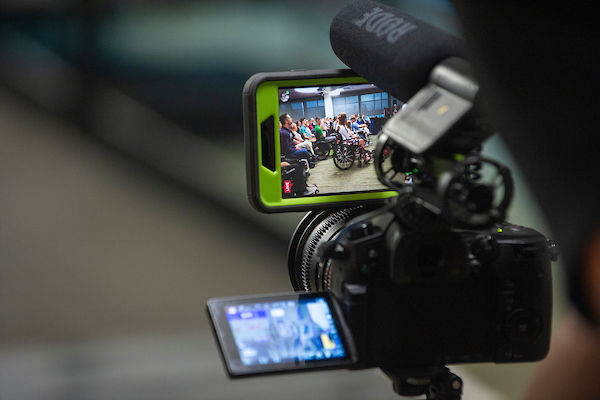The Friedreich’s Ataxia Scientific Symposium: Understanding a Cure recently marked its 9th year of bringing dedicated scientists, clinicians, and industry partners with patients and their families to USF – all whom share a commitment to finding effective treatments and a cure for Friedreich’s ataxia and related disorders. The Tampa Bay region is considered an epicenter for raising funds to support research for Friedreich’s ataxia, or FA. This year’s 10th Friedreich’s Ataxia Research Alliance (FARA) Energy Ball, held Saturday, Sept. 29, following the symposium and the association’s international FA biomarkers meeting, raised a total of $2.5 million to help bridge the gap between discoveries and treatment.
Hosted by FARA and the USF Ataxia Research Center, the scientific symposium drew an audience of 700 — both live at the USF Health Center for Advanced Medical Learning and Simulation (CAMLS) and viewing the event in real-time through YouTube.

From left: Paul Avery, Dr. Theresa Zesiewicz, Dr. Charles J. Lockwood, Dr. Clifton Gooch, Jennifer Farmer, and Ron Bartek
FA is a rare inherited neuromuscular disease, typically diagnosed in children and adolescents, that progressively robs patients of their ability to walk, speak and function and can ultimately lead to early death. Currently, no drugs are approved for the treatment of FA.
Symposium participants discussed the latest FA translational research progress, as well as heard individual patient perspectives and from scientific and industry partners working with academia to move promising therapies into the clinical trial pipeline. Researchers are attacking the devastating disease using multiple approaches, including working to improve mitochondrial function and inhibit inflammation, to replace the protein (frataxin) deficient in individuals with FA, and to combine gene correction with hematopoietic stem cell therapy. They also look for targeted biomarkers to help clinicians better assess disease progression and the response of individual patients to investigational FA drugs.
USF Health is one of 11 sites in Friedreich’s Ataxia Collaborative Clinical Research Network, an international network of clinical research centers working together to advance treatments and clinical care for those living with FA. The USF Ataxia Research Center participates in the FA patient registry, the only worldwide registry containing demographic and clinical information on more than 2,000 patients with Friedreich’s ataxia.
Here’s a sampling of what some symposium speakers had to say:
Charles J. Lockwood, MD, senior vice president of USF Health and dean, USF Health Morsani College of Medicine
“Since 2008, this symposium continues to be a major annual event broadcast around the world… We will never stop looking for answers. We will never stop looking for a cure.”
Theresa Zesiewicz, MD, professor of neurology and director, USF Ataxia Research Center
“At USF we have several active trials for FA, and we are close to finding a treatment to arrest disease progression and help alleviate some of the symptoms of FA. We are working towards offering even more clinical research in the future.”

From left, the Patient Panel, moderated by FARA Communications Director Felicia DeRosa, included: Laurel Avery of Florida, Sam Hill of Maryland, Annie Hamilton of New York, and Allison Dana of South Carolina.
Patient Panel: Living with FA and Research Participation
Laurel Avery, 23, Tampa, FL, currently working on her master’s degree in entrepreneurship
“When I first started college, people automatically assumed that I need help with everything. That’s a misconception, because the FA community is very adaptable and everyone works very hard to be resilient and strong.”
Sam Hill, 14, Annapolis, MD
“I’m proud that I’m able to keep up at school, even though I get tired easily. I like math and science.”
Advocacy Organization Panel
Sanjay Bidichandani, PhD, FARA scientific director and head of genetics at the University of Oklahoma College of Medicine Department of Pediatrics
“From the beginning of when the FA gene was found until today, all the discoveries are now nodes or targets for therapies being developed.”

Advocacy Organization Panel participants included, from left: Sanjay Bidichandani, PhD, FARA scientific director; FARA President Ron Bartek; and Pat Ritschel, FARA board director
Ron Bartek, FARA president and co-founder
“We realized from the get-go that to develop a treatment and cure for this disease we’d need to build relationships with patients and their families, with academic investigators, with government partners at the NIH, FDA and Congress, and with industry partners. With our encouragement, all of those stakeholders are now members of the family… Collaboration is FARA’s middle name.”
Pat Ritschel, FARA Board director
“By spending our effort to remove roadblocks, we attract more companies willing to work in this space of FA research… because the way forward is clear and they can see a path to the clinic and (drug) approval.”

The Scientific Panel included, sitting from left: Carole Ben-Maiman, MD, CEO of Chondrial Therapeutics; Stephanie Cherqui, PhD, associate professor at UC San Diego; Hao Wang, PhD, senior scientific director at Clinical Neuroscience-CNS TAU, Takeda Pharmaceuticals; and Kara Eichelkraut, senior manager of patient advocacy for Reata Pharmaceuticals.
Scientific Panel – FA Treatment Approaches
Jennifer Farmer, FARA executive director
“We have lots of different treatment approaches in various stages of development. This is very important, because we know that there is no disease fully treated with just one drug or one therapy.”
Hao Wang, PhD, senior scientific director of Clinical Neuroscience-CNS TAU, Takeda Pharmaceuticals
“The patients have educated us about their diagnosis and journey, and what kind of treatments they need. They have a great sense of humor despite the difficulties they are experiencing… The feedback we received from them has helped with study design.”
(Takeda’s investigational drug candidate TAK-831 is in a phase 2 clinical study to evaluate the enzyme inhibitor’s effectiveness on upper extremity motor function and manual dexterity.)
Kara Eichelkraut, senior manager of patient advocacy, Reata Pharmaceuticals
“Anything and everything anyone in this room does to contribute to FA research makes a difference. If it’s participation in a clinical trial that’s great, but if you cannot do that there are other things you can do, like providing a cheek swab or giving a vial of blood.”
(Reata received orphan drug designation for omaveloxolone for investigational treatment of FA by the FDA and EMA. FARA is enrolling 100 patients in a phase 2, part 2 clinical trial.)
Closing Comments
Clifton Gooch, MD, chair of neurology, USF Health Morsani College of Medicine, thanked participants for their courage and inspiration
“Twenty years after the founding of FARA we have over a dozen clinical trials focused on getting at the very heart of this disease in the genes themselves, using techniques of genetic engineering and modulation, therapies to support the mitochondria, and others… There is great reason for hope.
“Once we find the genetic therapy that treats this disease we will have the tools to prevent it in those who have the aberrant gene, to fix the gene so that they never develop the disease… That’s the world we’re working towards. We want to make FA a footnote in the medical literature, like smallpox.”
-Videos by Torie M. Doll, and photos by Eric Younghans, USF Health Communications and Marketing











